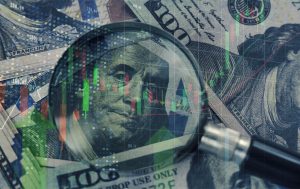In the aftermath of the U.S. consumer price index (CPI) report released on Thursday, speculation is rife among Tokyo market participants that Japan’s Ministry of Finance (MOF) ordered a fresh round of foreign exchange (FX) intervention. The immediate question is whether there will be follow-up action if the effects of the latest moves prove to be short-lived.
Following the U.S. CPI release, USD/JPY experienced a significant drop from 161.76 late in the Asian session and 161.62 post-CPI to a low of 157.40 on the EBS platform. It is likely that the Japanese authorities’ intervention was substantial, with EBS volumes estimated at $40 billion in the hours following the CPI release, which is five times the average volume for an entire day.
There is also speculation that another round of intervention might have occurred early Friday in Tokyo, as USD/JPY fell sharply from a retracement high of 159.45 to 157.75. Although this could reflect nervousness among USD/JPY longs, the three-figure move cannot be overlooked.
MOF official Masato Kanda has not confirmed any intervention but remarked that recent FX movements were inconsistent with fundamental factors. U.S. interest rates have recently declined, while Japanese government bond yields have reached levels not seen since July 2011. Kanda also highlighted that the recent rapid rise in USD/JPY was driven by speculation, which negatively impacts households. USD/JPY rose from a low of 140.27 on December 28 and from 151.86 after the last intervention at the end of April to a peak of 161.96 on July 3.
On Friday, USD/JPY found support around its 55-day moving average at 157.57 before rebounding to the 159.00 handle due to Japanese importer and NISA-related bids. With such flows expected to continue, further FX action may be necessary if USD/JPY climbs higher again, potentially threatening more Japanese importer option barriers starting from 162.00.
Market data showed that USD/JPY plunged from 161.62 to 158.30 on the EBS platform overnight in New York. Early in the Asian session, it saw another decline from a retracement high of 159.45 to 157.75, amidst rampant talk in Tokyo of Japanese stealth FX intervention, as reported by Asahi. Kanda has expressed confusion over reports of intervention but noted that the 5% rise in USD/JPY over the past month is significant and fast, likely driven by speculators, and has pushed up import costs.
Fundamental indicators suggest that the yen is too weak, given the decline in U.S. rates and the rise in Japanese government bond yields. Market expectations are now firmly set on a Federal Reserve rate cut in September, with another cut potentially following later this year. Japanese importer and other buying interest are already noted, with more expected on further dips.
Significant option expiries today include 157.60 ($390 million), 158.80 ($501 million), 159.00-05 ($886 million), 159.30 ($441 million), 160.00 ($1.2 billion), and 160.50-60 totaling $1.6 billion. Volatility is likely throughout the day, with the threat of further intervention looming.
On Friday, the Japanese yen fluctuated around 159 per dollar and is expected to remain volatile after a sharp rebound in the previous session, suspected to be driven by intervention from Japanese authorities following the cooler-than-anticipated U.S. inflation data. The yen surged by as much as 2.6% to 157.42 per dollar on Thursday, with local media attributing the move to official buying aimed at supporting the currency after it hit 38-year lows.
The Nikkei also reported that the Bank of Japan (BOJ) conducted rate checks with banks on the euro-yen cross on Friday, raising concerns about further intervention. Meanwhile, top currency diplomat Masato Kanda refused to confirm whether the government had intervened in the yen’s rally. Investors are now looking forward to the BOJ’s policy meeting in late July, where it is expected to announce its bond purchase tapering plans and potentially raise interest rates again.
In conclusion, there is little doubt among Tokyo market players that the MOF ordered the BOJ to intervene in the FX market following the weak U.S. CPI report. The timing of the intervention was almost perfect, with lower U.S. rates contributing to the yen’s move upwards. The spike in EBS volumes to around $40 billion post-CPI, five times the average, supports this theory. Another wave of intervention was likely seen early in Tokyo as USD/JPY fell from 159.45 to 157.75. While the market awaits further MOF moves to stabilize the yen, dealers are reporting rate checks in EUR/JPY as well. USD/JPY is finding support near its ascending 55-day moving average at 157.56, with further volatility expected as the threat of more intervention looms.




